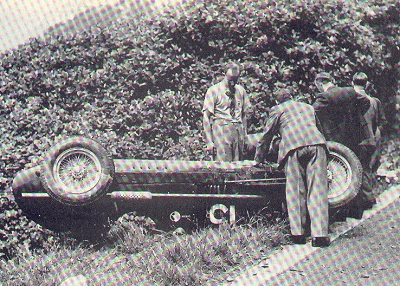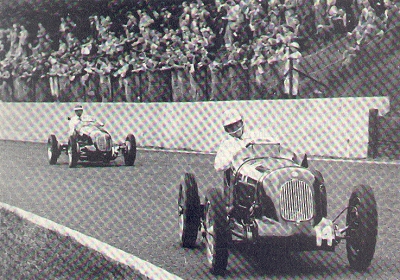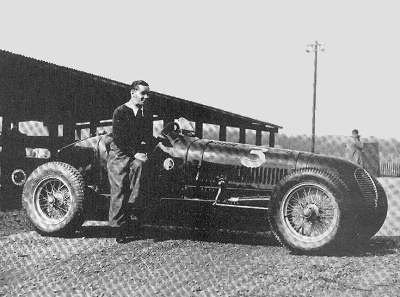| Tipo 4CM - No.1128 The story of a race car |
|
I would like to thank 'Motor Sport' magazine for their kind permission to reproduce the contents of this excellent article by Denis 'Jenks' Jenkinson, that appeared in the June 1977 issue of 'Motor Sport', for your enjoyment. |
The Maserati factory in Bologna produced a new model for 1936 "voiturette" racing, which had a supercharged six-cylinder engine in a chassis with independent front suspension, large hydraulic brakes, and semi-elliptic rear springs supporting the rigid rear axle.
This was the 6CM and it proved the equal of the ERA, but not necessarily superior. For 1937 the basic design of the 6CM was followed, but a 4-cylinder 1½-litre engine was used, it being thought that the "four" was livlier than the " six", especially for twisty circuits. In Milan was a private group of racing enthusiasts who had got together to form the
Scuderia Ambrosiana, and one of these was Count Giovanni Lurani Cernuschi, known to his many English friends as "Johnny" Lurani, his racing connections with the English going back to the 1933 Mille Miglia when he drove a K3 MG Magnette with Capt. George Eyston. The patron saint of Milan is Saint Ambrose and anything that is thoroughly Milanese is "Ambrosiana",
hence the title for this team, the other founder members being Luigi 'Gigi' Villoresi and Franco Cortese. One of the top football teams in Italy at the time was the Ambrosiana International Football Club (today better known as Inter-Milan) and Lurani asked the President of the Football Club, a Signor Pozzani, to be the President of their Scuderia and they adopted the
blue and black of the football team in their Scuderia badge.
In national Italian racing at the time there was quite a following for the 1100 cc category, so when the Scuderia were euipping themselves for the 1937 season, Lurani ordered an 1100 cc version of the new 4-cylinder car, with spare cylinder block and pistons, supercharger, connecting rods and so on, to convert it to 1500 cc if required.
This was Maserati Tipo 4CM chassis number 1128, supplied in 1100 cc form, and like the 1500 cc versions, had a two inch shorter wheelbase than the 1936 cars. Throughout 1937 Lurani was very successful with this car, winning the 1100 cc category in races at Turin, Milan, Genoa, Naples, Palermo and in the Frieburg hill-climb in Germany. Not surprisingly these successes netted him
the 1100 cc Italian Championship. At the end of the season the engine was converted to 1500 cc and Lurani visited Great Britain, to run in the Imperial Trophy race at the Crystal Palace. He was third in the first Heat, behind Percy Maclure and Arthur Dobson, and fifth in the Final behind Bira, Dobson, Goodacre and Villoresi.
In the winter of 1937/38 the Scuderia Ambrosiana took four Maseratis to South Africa, for the winter season, Lurani taking his 1100 and Taruffi, Villoresi and Eugenio Senna taking six-cylinder 1500 cc cars. Their first race was on the Lord Howe circuit near Johannesburg and was a handicap event, based on engine capacity. Lurani felt that the organisers
were being much too lenient with his 1100 cc and asked to be re-handicapped, mainly to give his three compatriots with the 1500 cc cars a better chance. The result was that he finished third, behind two local drivers! They then went to East London and in this race Lurani was dicing with the South African ERA driver Norman Wilson, when the little Maserati threw a connecting rod
out through the crankcase. Their last race was in Cape Town so the crankcase was patched up and the 1500 cc cylinder block and pistons were fitted. Most of the efforts were put into the other team cars, Lurani's 1500 not being taken too seriously, so he had to start the race on what tyres were left over, and pulling the wrong axle ratio and so on. He drove round disconsolately
in 6th place until he was due to stop and refuel, and then feeling a bit fed up with it all he handed the car over to Luigi Villoresi, whose six-cylinder had blown up. Villoresi stormed back into the race and drove really hard, working his way up to third place by the finish, being beaten by Lord Howe (ERA) and Taruffi (Maserati). Among the British entries was W G 'Bill' Everitt
who drove a Maserati and during the voyage back to Europe on the P & O liner "Winchester Castle" Lurani and Everitt travelled together, already being good friends from previous races.
Back in Italy the Maserati No 1128 was rebuilt in readiness for the European season and Lurani had the rear end modified. A firm in Turin was making suspension units compromising a coil spring within a tube, with the springs being actuated by a trailing arm, these units being primarily intended for the front end of racing cars, to give a "bolt on "
independent front suspension. Lurani had these units fitted to trhe rear of the Maserati, to replace the semi-elliptic springs, still retaining, the one-piece rigid rear axle. It was felt that the Tecnauto coil-spring units would give a better ride to the rear end and stop it hopping about, which proved to be correct. The first big race for Scuderia Ambrosiana was the
Tripoli Grand Prix, over 517 kilometres on the very fast Mellaha circuit in North Africa. There was a 1500 cc category within the Grand Prix itself and for this event Maserati 1128 was in 1500 cc form. Lurani was leading the "small car " category when all the oil pressure disappeared and thinking the oil pump had packed up he pulled into the pits. After six minutes
the trouble was traced to a faulty guage and he rejoined the race, to finish third in the 1500 cc group and eighth overall.
Still running in 1500 cc form Lurani then went to the Targa Florio, whuich was being run as a circuit race in Palermo. After making second fastest practice time he had a collision with Bianco in the race and ended up off the course. Lurani had actually been leading to begin with, but his fuel-pressure played up and the car slowed, allowing Bianco
to go by. Then the Maserati picked up again and while overtaking Bianco, Lurani was "elbowed off". |
 The Maserati 1100 after being inverted at the Crystal Palace by "Johnny" Lurani in 1938. Damage was very light: "I acted as a cushion for the car when it landed" says Lurani. Photo from Cyril Posthumus ©. |
Converting the engine back to 1100 cc, for handicap purposes, Lurani entered for the London Grand Prix at the Crystal Palace in June but disaster struck. During practice he got into a big slide on a streak of oil spilled out by Norman Wilson's ERA, went off the road and overturned. While the car was only superficially damaged, poor Lurani broke his hip very badly and though he was repaired in a London hospital and was out and about before the end of the season, the injury put paid to any more single-seater racing for him. He had to restrict himself to the more"comfortable" sports cars and saloon cars in the future, While he was being cared for in the clinic, the Maserati was put back on its wheels and straightened out and Lurani's friend Bill Everitt drove it in the London Grand Prix, but was forced to retire with engine trouble. While convalescing Lurani lent the Maserati to Achile Varzi for a small race in Lucca, but no success came their way. |
 W G 'Bill' Everitt in the Maserati, following JHT Smith (MG Magnette K3) into Ramp Bend in the London GP at the Crystal Palace in 1938. Photo from MOTOR SPORT ©. |
With his single-seater career over, Lurani put the little Maserati up for sale, taking an illustrated advertisement in The Motor. |
| Maserati single-seater full 1938 model. Latest type 4-cylinder single-block 1500 cc racer. Special Memini double carburettor. Car complete with 2 duralumin Rudge wheels, 3 spare gear ratios and complete spares for converting engine to 1100 cc. Car with 1500 cc guaranteed to exceed 140 mph. In 1938 did fastest lap at Tripoli GP, race average 116 mph, finished third. In 1939* was third in Grosvenor Grand Prix at Capetown. Car and all spares in perfect, faultless condition, guaranteed and ready to race. 1100 cc engine fastest ever produced by Maserati. Count Lurani, c/o British Racing Driver's Club, 12 Queen's Gate Terrace, London, S.W.7. * this was a mis-print for 1938 - D.S.J. |
| The price being asked in the advertisement was £795. "Oh Happy Days!" |
Eventually Desmond Scannell, the secretary of the BRDC, traced Lurani in Nice, and a deal was done over the phone on behalf of Charlie Dobson, who wanted the car in 1100 cc form for the 1939 British Empire Trophy race. It was agreed that Lurani's mechanic would take the car to Donongton Park, in time for practice, and the money would be handed over in the paddock. Lurani's mechanic was Carlo Facetti, the father of the Facetti who races Alfa Romeos today, (this article published in 1977) and after he had fitted the 1100 cc block and pistons etc., he loaded it on to their special Fiat transporter and set off for England, all on his own and unable to speak a word of English. While crossing the Alps he was caught in a heavy snowstorm, and unbeknown to him some water had remained trapped in the cylinder block, even though he had drained it before setting off, and it froze. Eventually he arrived at Donongton Park and unloaded the car, but when he filled it with water he discovered the frost crack in the block. Not naturally Dobson was not prepared to accept the car on behalf of his sponsor, one José Dibos. Poor Facetti was distraught, and dreaded the thought of taking the car back to Lurani unsold, with all the costs of the journey to be paid. With the help of other people in the paddock he got the cylinder block into Rolls Royce, in nearby Derby, and it was repaired. Working non-stop through the night Facetti got the car re-assembled and running and next day Dobson tried it and was delighted and the deal went through, much to Carlo's relief. |

A smiling C J P Dodson posing with the Maserati No 1128 in the Paddock at Donington Park before the 1939 British Empire Trophy race. The car carries the blue and black Scuderia Ambrosiana badge on the side of the scuttle. Photo from Cyril Posthumus ©. |
In the race the car ran well and Dobson was on great form, working the car through into second place. Reports at the time said that the repaired block had failed, which caused his retirement, but Lurani says that what actually happened was that an oil pipe became blocked and starved the feed to one of the camshafts and it seized. Whatever actually happened, the new owner was well satisfied with the way the car had gone, and Charlie Dobson was obviously
happy driving it, so Facetti was able to return to Italy and report the deal as having been completed.
It ran once more in 1939, at the Nuffield Trophy race, also at Donington Park but this time it was a scratch race for 1½-litre cars. Dobson ran well until near the finish when the mounting for one of the Tecnauto units on the rear began to break away from the chassis, and the car limped into the finish looking a bit lop-sided. It was classified fifth out of the nine finishers, but was five laps behind the winner.
With the war starting shortly after this the Maserati was not seen again until 1948, when 'Johnny' Lurani came across it at a small meeting at the Montlhéry Autodrome, near Paris; it was painted blue and being raced by a French driver. Once more it disappeared and came to light in Marseilles in the middle nineteen-sixties, for sale and looking very sorry for itself,
Lurani declined the offer to buy it and it eventually went to a Swiss enthusiast who has it now (this article published in 1977), in fully restored condition and looking in very good health. - D.S.J. |
 |
||
|
To enter Enrico's Maserati Pages CLICK HERE! Copyright: Enrico's Maserati Pages - © 2000-2004. All rights reserved. |